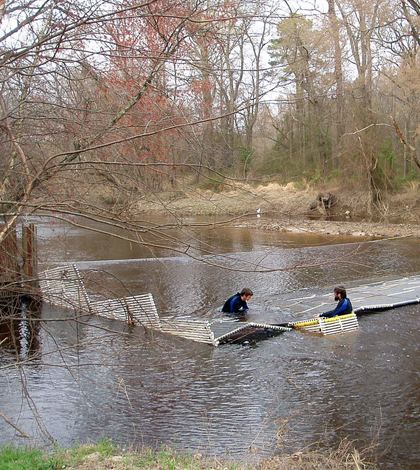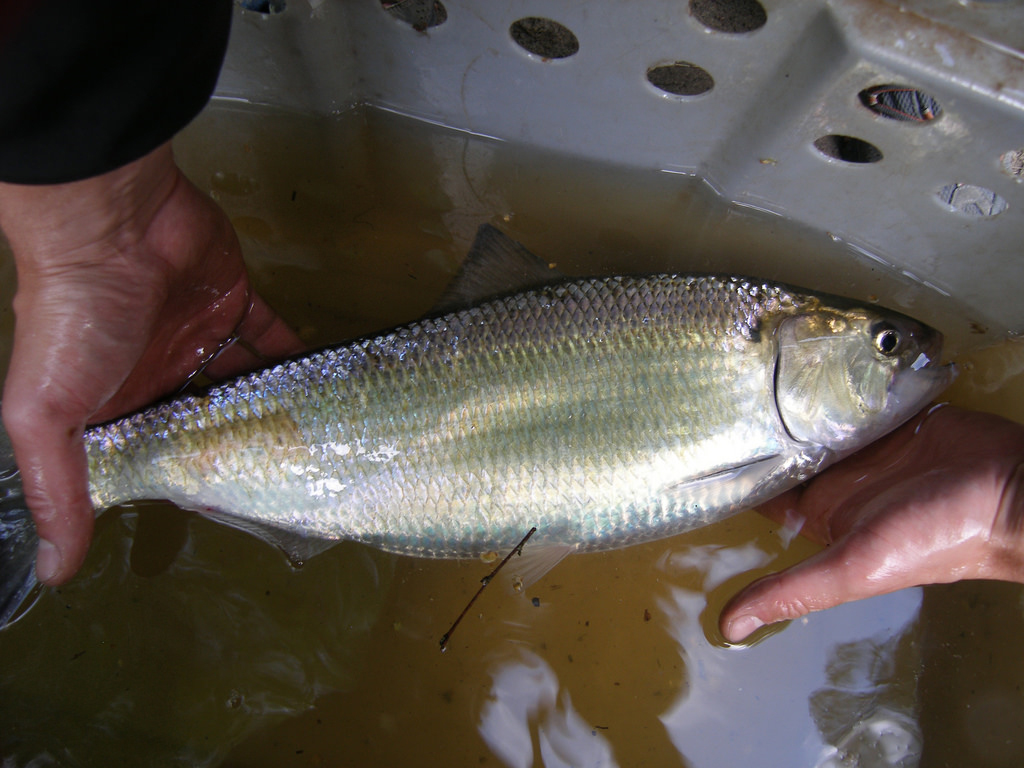Study tracks American shad spawning survival in species’ North Carolina ‘purgatory’

Installing the weir for the American shad study on the Little River (Credit: Joshua Raabe, via Flickr)
The American shad is one well-travelled fish. This cousin to the herring makes a yearly journey from its Atlantic home up through coastal streams and rivers to spawn. The trip is all business, no pleasure — most of the fish will never see the ocean again. But with each female laying about 30,000 eggs per batch, and hundreds of thousands of eggs each year, the species’ survival seems assured.
But natural behavioral patterns developed through millennia of adaptations offer little use against the commercial fishing operations, chemical pollutants and damming of the past 200 years. These factors led to a decline in shad populations as early as the end of the 19th century. Once a staple of the United States’ coastal economy, today shad populations are at an all-time low.
Scientists from the U.S. Geological Survey and North Carolina State University conducted a study about the disappearing fish in North Carolina’s Little River, a spawning ground where three dams were removed between 1998 and 2005. Another partially removed, or “notched,” dam still stands, but permits decent fish passage and streamflow.
“American shad were historically very important to the U.S. East Coast,” said Joseph Hightower, USGS biologist. “They supported large fisheries, employed a lot of people and provided a source of protein.”
The shad was a victim of its own popularity, in part. While overfishing dented the shad’s numbers, dam construction stifled its ability to breed by blocking access to historic spawning grounds. Shad prefer to spawn far upstream, where cobble substrate improves their eggs’ survival rates.
Hightower and co-author Joshua Raabe of NCSU wanted to learn how American shad communities would respond to the Little River’s recent undamming. From spring 2007 to 2010, the researchers captured, tagged and tracked thousands of migrating shad along with the river’s regular residents.

The researchers built a weir that funnels fish into a cage. (Credit: Joshua Raabe, via Flickr)
The sampling process kept the researchers’ feet wet and their hands dirty. Most days, the team balanced atop planks above a resistance board weir, scooping fish out of live collection cages for tagging. When high waters rendered the weir useless, the team waded into the river armed with nets — and a 230 volt Georator generator wired through a portable boom.
Electrofishing, as the technique is known, employs an electrical current to lure and stun fish. It can be performed from within the water or onboard a boat.
“It’s a good way of sampling fish quickly without doing any harm,” Hightower said.
Shad captured with either sampling method found themselves the recipients of a little field surgery: Researchers made small incisions between the pectoral and pelvic fins of each fish to insert a rice-sized PIT tag, or passive integrated transponder. The researchers then released the fish up or downstream, based on their original direction of travel.

Female American shad captured at a fish weir on the Little River, North Carolina (Credit: Joshua Raabe, via Flickr)
To track the freshly tagged specimens, the team installed seven PIT antennas along the banks of the river. In spite of its name, Hightower said Little River is “probably the largest river the PIT antennas have ever been used on.”
A focus on individual specimens separates this study from its predecessors, Hightower said. Many previous studies on the American shad required researchers to net and weigh fish en masse, restricting the scope of statistical analysis.
Shad eat next to nothing and swim against heavy currents — and over dams, when possible and necessary — as they head upstream to spawn. The researchers observed up to 30 percent weight loss in males, and 50 percent in females. Onset HOBO-TEMP loggers and USGS monitoring stations provided temperature, discharge and gauge height data, revealing a positive correlation between weight loss and cumulative water temperature.
An examination of shad predation near the river’s remaining notched dams indicated that some predators, such as the flathead catfish, use the dams at strategic bottlenecks to catch their prey.
“The flathead catfish tended to hang out below that dam,” Hightower said. “What we think they’re doing is waiting there to catch the shad.” The team even found one flathead with a shad PIT tag in its stomach.

A PIT antenna installed on a bridge detects tagged fish (Credit: Joshua Raabe, via Flickr)
North Carolina is a kind of purgatory for the American shad. Shad populations in the north return to the same spawning grounds year after year, while their southern neighbors live to breed just once before dying. North Carolina shad seem to breed more than once when given the opportunity, but even with the Little River’s dams removed, few of the fish ever leave its waters.
“Only about 10 percent of the fish that came in to spawn made it back out,” Hightower said. “That’s a pretty high cost of spawning.”
Although spawning poses a serious challenge for the shad with or without obstructing dams, Hightower said dam removal can have positive effects on all of a river’s inhabitants.
“My general feeling is that in most cases, when a dam is no longer needed and can be removed, it benefits the ecosystem,” Hightower said. “My hope is that a [follow-up] study will be done in 5 to 10 years.”
“Hopefully what we’ll see is an increased population.”
Top image: Installing the weir for the American shad study on the Little River (Credit: Joshua Raabe, via Flickr)




0 comments